#vaqueiros de alzada
Text
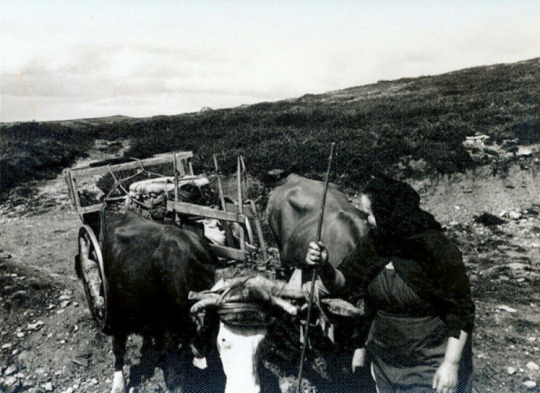

A Vaqueira de Alzada woman migrates to the summer brañas of Los Corros and Las Tabiernas from the winter brañas of Silvallana and Brañaescardén in the spring of the early 1970s.
The spring migration (l'alzada) is the happiest time of year for the Vaqueiros. Traditionally cattle are dressed in special headgear with bells and Vaqueiros sing songs and ring bells to announce their joy at the arrival of spring and their return to the summer brañas.
The Vaqueiros are a small traditionally nomadic people indigenous to northwestern Spain.
Photos: María Cátedra Tomás, Muséu del Pueblu d'Asturies, 1970-75
#vaqueiros de alzada#vaqueiro#spain#indigenous#indíxena#love the chickens in the cage in these fotos#she migrates with the chickens [heart eyes]#the cattle in this fotos dont seem to be wearing the special headgear#though there is more photos from this same day of another household where the cows are wearing the special headgear
42 notes
·
View notes
Note
Sorry you are getting so much hate! Love and solidarity from the Vaqueiros de Alzada with the many Indigenous peoples whose land has been colonized by Russia ♡
Fortunately, it's only been a recent occurrence and with one hateful guy and a misled person trying to claim I'm like them.
Thank you so much for the solidarity and the love. I appreciate you so much! ❤️
1 note
·
View note
Note
Europeans think far too much of themselves as far as human rights. The nomadic Vaqueiros de Alzada of Spain get treated horribly, with no recognition or land rights, many in the brañas lack electricity and running water, and we are still in the midst of a suicide epidemic. Europe can brag so much about all it has done but it won't even confront its own dirty history.
Ah, I’m sorry to hear about that! I had no idea, that’s fucking awful. But really it’s. the cockiness is SO displaced, but then to make fun of America and Canada of all places for doing the same thing?? Like who do you think we learned it from lol??
11 notes
·
View notes
Text
Nos hemos venido arriba. Han tenido que pasar más de 2 años de blog para escribir el primer post sobre Asturias, pero ¡ya vamos por el segundo! Probablemente es la transposición de nuestro sentimiento respecto a esta tierra: la tenemos siempre tan a mano, vamos tan a menudo que no nos damos cuenta de lo mucho que nos gusta hasta que empezamos a hablar de ella o alguien nos pide consejo sobre qué ver o hacer en su próximo viaje allí.
Ya que empezamos con una celebridad (los lagos de Covadonga en Picos de Europa), creemos justo ahora sacar a la palestra otro rincón asturiano menos famoso. El Parque Natural de Somiedo es ese eterno actor secundario que nunca atrae los brillantes focos pero que hace un sólido trabajo, constante, dejando siempre feliz a quien, sea buscado, sea por casualidad, le conoce. En sus casi 30.000 hectáreas extiende sus variados registros: todos los tipos posibles del bosque de Asturias (hayas, robles, fresnos, arces) y numerosos ejemplares de la fauna autóctona: ciervos, águilas, lobos, jabalíes… ¡y casi la mitad de los osos de la cordillera Cantábrica! No es de extrañar que muchos de sus visitantes lleguen a él con la esperanza de avistar un imponente oso pardo (y no tan extraño el llegar a verlo).

Desde el Mirador del Príncipe es posible ver osos pardos: justo llegamos cuando habían avistado a una hembra y su cachorro el día anterior
Pero Somiedo tiene más ases en la manga. Su territorio recoge cuatro grandes valles que oscilan entre los 2.194 metros del pico El Cornón y los 400 metros de Aguasmestas. También numerosos lagos y lagunas, entre los que destacan los de Saliencia. Incluso unas construcciones, los teitos, que sólo se dan aquí: casas de piedra de planta cuadrada con tejados de madera y cubierta vegetal. Muestra de una cultura única que se extiende por todo el occidente de Asturias, los vaqueiros de alzada. Todo un mundo por descubrir.

Otro de los grandes alicientes de esta ruta es que puedes ver numerosos teitos: construcciones típicas de Somiedo con tejados de madera y cubierta vegetal
Hay numerosas rutas para conocer el Parque de Somiedo: la que te proponemos aquí es muy asequible, sin apenas dificultad. Y además de sus maravillosos paisajes verdes, te premia con la visión de varios teitos y con el trofeo final del Lago del Valle, que con sus 24 hectáreas es el más grande de Asturias. El itinerario parte del pueblo del Valle y atraviesa el Valle del Lago. De ahí el nombre: Ruta del Valle del Lago (no es un trabalenguas aunque lo parezca).
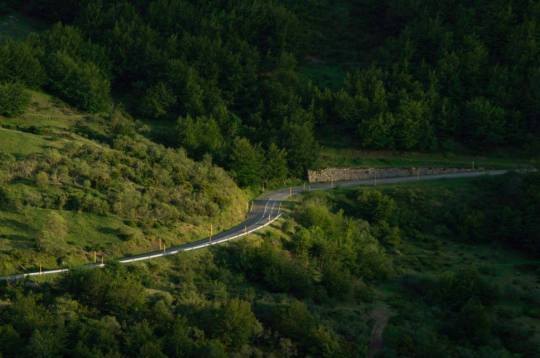
La carretera desde Pola de Somiedo con sus verdes paisajes enmarcándola
Mejor empezamos por el principio. La ruta tiene su punto de inicio en el pueblo Valle de Lago, a 1.200 metros de altura, al que se accede por una carretera de agárrate-que-vienen-curvas desde Pola de Somiedo (la capital del concejo en que se ubica el Parque). Hay que atravesar todo el pueblo para llegar al camino donde arranca la caminata y donde podrás aparcar el coche.

La ruta parte del pueblo del Valle, es lineal y recorre 12 kilómetros ida y vuelta
Es una ruta sencilla, 6 kilómetros para ir y otros 6 para volver, bien señalizada, si bien el camino de ida transcurre fundamentalmente cuesta arriba (hay que subir literalmente al lago). Atraviesas campos de siega en primer lugar: de hecho son terrenos particulares cuyos dueños han colocado advertencias al respecto de lo más peculiares.
El camino pronto empieza a ascender para llegar al Lago del Valle
Cartel curioso que encontramos durante la ruta al Lago del Valle
Y ahí estaba el toro al que se refería el cartel
A continuación pasas una zona de arboleda. En la primera bifurcación que encuentras, tomas el camino de la izquierda. Continúas y en el segundo cruce puedes elegir entre caminar a cielo descubierto (si tomas la vía de la izquierda) o pasear bajo la sombra de un hayedo recorriendo algo más de distancia (vía de la derecha). Al gusto del consumidor. Nosotros tomamos el camino corto bajo el sol para finalmente llegar a la pradera donde se encuentra el lago.
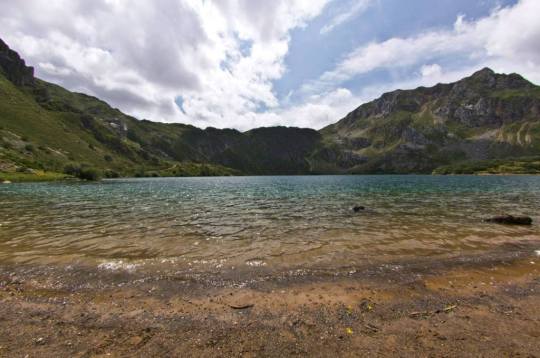
El Lago del Valle en el Parque de Somiedo, Asturias
Éste permanece invisible al estar hundido en su valle y solo aparece ante ti cuando ya el camino ha finalizado. Lo mejor tras alcanzarlo es rodearlo por una de sus orillas para sentarse en un pequeño promontorio desde el que las vistas son mucho mejores.

Y por fin la meta: el lago del Valle
Tómate tu tiempo para disfrutar del paisaje, comer, beber, recuperar fuerzas y tomar fotos para después emprender el camino de vuelta, deshaciendo lo andado hasta el pueblo del Valle.
Como es un trekking sencillo y corto, te proponemos otro plan para completar el día. Acércate al Mirador del Príncipe, en el pueblo de La Peral. La panorámica del Parque de Somiedo merece la pena y si tienes suerte, incluso puedes avistar algún oso pardo. Para llegar, debes volver hacia Pola de Somiedo y desde allí tomar la carretera al Puerto (AS-227) hasta encontrar un desvío a la derecha a La Peral. Hay un parking justo a la entrada del pueblo donde deberás estacionar pues el acceso en coche solo está permitido para los vecinos. Atraviesas el pueblo a pie y llegarás al espectacular mirador. ¡No te olvides la cámara de fotos!
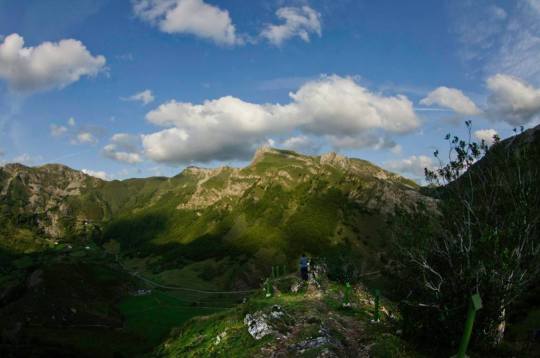
Las vistas del Parque de Somiedo desde el Mirador del Príncipe son espectaculares
Ruta del Valle del Lago en Somiedo, Asturias Nos hemos venido arriba. Han tenido que pasar más de 2 años de blog para escribir el primer post sobre…
0 notes
Photo

Vaqueiro de Alzada, Balbino Arnaldo Antón, “El Bígaro”, uses a conch shell to call neighbors to a meeting, in the braña (ancestral Vaqueiro settlement) of Abedul, in the summer of 1986.
This use of the conch shell, called el turuxu, in the local language, may also take the form of a cattle horn and is an endangered Vaqueiro tradition. The turuxu is also used to ward off thunderstorms and to scare predators away from livestock.
The Vaqueiros are a small traditionally nomadic people indigenous to northwestern Spain.
Photo: José Enrique Cima, La Nueva España, 02 Sept 1986
33 notes
·
View notes
Text
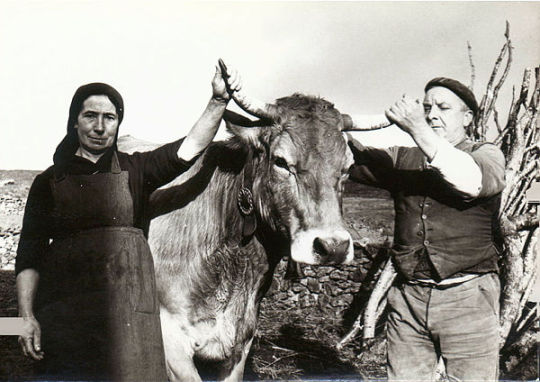

José García Ardura, "El Rey de Escardén" (The King of Escardén), a Vaqueiru man, alongside his wife and one of their cows in their summer braña of Busteḷḷán (Bustellán) in 1952. His nickname comes from his winter braña of Brañascardén (Escardén) and possibly his house name, Rei/Rey. The Vaqueiro house system is a complex system of kinship, inheritance, and land division which plays heavily into Vaqueiro cosmology.
The Vaqueiros are a small traditionally nomadic people indigenous to northwestern Spain.
Photos: Julio Antonio Fernández Lamuño (1920-2022), Muséu del Pueblu d'Asturies
#i'm probably distantly related to them!#him in particular#vaqueiro#vaqueiros de alzada#nomadic#indigenous#indigenous peoples#asturias#spain
10 notes
·
View notes
Text
y para todos hispanohablantes (información sobre los vaqueiros! en español!)
@terraqueoybiuniversal me alegro que hayas preguntado! recomiendo wikipedia para los anglohablantes porque existe casi nada sobre los vaqueiros en inglés. además, no me gusta mucho el articulo de los vaqueiros de wikipedia español, no tiene mucha información y mucha de la información que tiene es sobre el festival vaqueiro :/
en español, existe mucho más, pero depende de nivel de información que quieres. he investigado los vaqueiros durante casi 6 años. tengo muchas opiniones sobre todos los recursos informativos.
primero, recomiendo el sitio del web del concejo de cultura vaqueira. es lo más parecido que tenemos a un órgano representativo. tiene enlaces a artículos sobre los vaqueiros y también recomienda algún literatura sobre los vaqueiros. https://ccvaqueira.es
segundo, el sitio de gonzalo gayo y su organización, la asociación cultural de los vaqueiros de alzada de asturias la brañina (pienso que ya no existe y se reemplazó por el concejo de cultura vaqueiro del que forma parte). es sitio un poco viejo y anticuado y pero la información es buena y gayo es un buen escritor (he hablado con él varias veces!) http://vaqueiros.es/
siguiento, si buscas información en manera accesible, gayo creó un folleto con información preliminar sobre los vaqueiros que me gusta mucho. grandes fotos, buena información y escritura. https://issuu.com/gonzalogayo/docs/vaquierosdossier
por último, si te gustaría leer un libro, tengo muchas recomendaciones. tengo casi todos los libros que aparecen en la lista de ccvaqueira. pero ante todo,
recomiendo cualquiera los libros sobre los vaqueiros por maría cátedra. tienen mucha información única pero cubren los aspectos básicos y cátedra es una escritora y investigadora fenomenal. en particular, agradezco cómo trataba a los vaqueiros con respeto, especialmente para ese período del tiempo.
este otro libro recomiendo con precaución. es uno de los primeros libros con énfoque antropólogo sobre los vaqueiros, aunque existen actas cientos de años antes acerca de los vaqueiros. se publica originalmente en los 1890, y pienso que no es tan díficil de leer. la primera parte es sobre los vaqueiros, la seguna parte, no importa, trata de los celtas antiguos y las teorías del autor. el problema es que el autor tenía un tiempo difícil distinguiendo entre los vaqueiros de alzada y los ganaderos no vaqueiros ('vaqueros') y clasificó casi todos los ganaderos en asturias como vaqueiros. sin embargo, lo recomiendo porque es de de dominio público y por lo tanto se puede encontrarlo online gratis (legalmente!) y porque es un texto fundamental sobre los vaqueiros. y se menciona o cita en casi cada libro, sitio, artículo, etc sobre los vaqueiros. solo cógelo con pinzas. https://hdl.handle.net/2027/uc1.$b542728
espero que esto te ayuda aprender sobre los vaqueiros!
si alguien quiera más, avísame! tengo muchos!
aún más: si quieras ver y aprender de nuestras brañas, señor entomólogo tiene un blog que podría entretenerte para algunas semanas. tiene fotos y una pequeña historia de cientos de brañas, majadas e invernales en asturias (y algunas en león y cantabria). a menudo, son las únicos fotos de estas brañas que existe, por lo menos en el internet. otro conocido de yo, y un blog que visito regularmente. fotos extraordinarias. si la descripción no menciona que es una braña vaqueira, entonces esa braña no es una braña vaqueira, señor entómologo también visita a muchas brañas no vaqueiras inclusa majadas e invernales. https://rinconentomologo.blogspot.com/
2 notes
·
View notes
Text
vaqueiros will all die and then they will apologize and talk about how sad they are because we will be gone and they will have our land and its easier for them to be sorry to reap the rewards of killing us as a people than recognizing us and protecting us and giving us our land back
1 note
·
View note
Note
hallo ! vou escrever em português porque acho que nos entendemos sendo ambes da península ibérica, mas se for difícil de entender podes usar o google tradutor ou pedir para reescrever a mensagem em inglês! also respond in the language thats easiest for u 💛
estou super fascinade/obcecade com uma música vaqueira da tua playlist, a que começa aos 3:27 mins neste track: https://spotify.link/Dhd0cic1qJb
e queria perguntar se sabes se essa música tem um nome em particular ou se está nalgum cancioneiro vaqueiru que possa consultar ! gosto muito de cantar música tradicional ibérica com amigues (principalmente música minhota e música gallego-portuguesa medieval 🌟) e tenho ouvido esta música em "repeat"!! é tão linda !!
espero que estejas a ter uma ótima primavera e que a mensagem não tenha sido difícil de entender :^)
éi!!! i hope it is alright that i write this response in english and perhaps post publically, i can always translate if needed (into spanish or also i could try portuguese though i cannot promise it will come out as well). i do understand some portuguese and took a class through my university of portuguese for spanish speakers though that was a while ago and my portuguese is not great so i did also run it through a translator.
as i also mentioned earlier, this would be a vaqueirada. vaqueirada is a term for Vaqueiro music in general though also is a term for Vaqueiro music that conforms to certain standards, in particular usually 3/8 or 6/8 time. other Vaqueiro songs include gaḷḷegadas and xotas. to be honest, i played violin for over 10 years, and am not very good at classifying them. as far as i know this song i considered a vaqueirada.
the particular song you mentioned, starting at 3:27 of Esbilla de Vaqueiradas is called "Tengu lus güechus hincháus" (there are many ways this is spelled due to no standardization of the Vaqueiro language/dialect: Tengo los güechos hinchados, Tengu lus güechus hinchadus, etc....)
This vaqueirada was one of those recorded by famous American ethnomusicologist Alan Lomax in his trip to Asturies in 1952. His particular recording is actually sung by Juan Uría Ríu, a researcher well known for his work on the Vaqueiros. It comes from Santa María del Puerto/El Puerto del Somiedo. He notes the similarity between "Tengu lus güechus hincháus" and the Extremaduran romance "La bastarda y el segador". It is true that Vaqueiros in this area of southern Somiedo had contact with transhumant herders from Extremadura. The Vaqueiros here would sometimes buy merino sheep from these Extremaduran herders. It is likely that the similarity in these songs is due to their contact. The lyrics pabilun is the Vaqueiro onomatopoeia for hits on the pandeiru and shows up in a few other vaqueiradas as well as in this Extremaduran song.
Thank you so much for your interest in Vaqueiro music and culture! If you want to know more or hear more, I do have some documents and videos of interest:
This booklet is the work of Antón Ochoa and Rogelia Gayo. Rogelia Gayo was a Vaqueira singer of traditional vaqueirada. She has a sad story. She was popular before and after the dictatorship, when the Spanish govt and anthropologists began to take interest in the 'pueblos malditos' of Spain and wanted their own people to show off at places like the world fair similar to indigenous people in the Americas. Rogelia Gayo was extremely proud of Vaqueiro culture and music and for their interest, was chosen for this endeavor, and sang at the wedding of Alfonso XIII and also in Nazi Germany and Italy to display the Vaqueiro people as an anthropological spectacle. She saw the assimilation and massive population decline of Vaqueiros and so with Antón Ochoa, she recorded the lyrics of Vaqueiro songs across the brañas in 1929. Though her work was never released until 2014. Rogelia Gayo died in the 70s and today her grave is built over and unmarked.
Here is Alan Lomax's book of his trip to Asturies, parts of it are about Asturian xaldo (non-Vaqueiro) music and parts of it are about Asturian Vaqueiro music. You will find the lyrics and notes of "Tengu lus güechus hincháus" here. It is in both English and Spanish.
Here is some various short notes and papers from authors Fidela Uría Libano and José Manuel Fraile Gil on Vaqueiro music. On Vaqueiro dances. On Vaqueiro instruments. On traditional Vaqueiro music.
Here is the spotify album of Alan Lomax's recordings of his trips to Asturies. Again, not all of it is Vaqueiro music, you would have to read the booklet.
Here is one video of Las Tsacianiegas, a musical group of two Leonese Vaqueira sisters who do traditional Leonese Vaqueira music. They have no music on spotify but all on youtube, uploaded from lots of different people. The ones from Diputación León like this one are very well shot. They are all traditional songs save their one original song Xota de San Miguel de Laciana, which is very much based on traditional music.
let me know if any of these links do not work!
um, i hope this answers your question and you find this helpful! thank you again for your interest in Vaqueiro music and culture and for finding our songs beautiful! I also hope you have a great spring!
0 notes
Photo

Vaqueiros at a livestock fair in Navelgas (Cuartu los Vaḷḷes), 1970-75, María Cátedra Tomás, Muséu del Pueblu d’Asturies
#vaqueiros de alzada#vaqueiros#indíxena#to know i am probably related to them <3#maybe i will get copy right for this but son la mia familia ya sou vaqueira it belongs to me#vaqueiro
7 notes
·
View notes
Text
Happy day for Vaqueiros, our winning hopefully leads to better conditions and land rights and acknowlegement as a people (acknowledgement as Indigenous would be fantastic but at very least we look to be even seen as existing)
I love my people with all our heart, our culture, our brañas, our cattle. I am proud to be a Vaqueira ♡
#vaqueiros de alzada#indíxena#indigenous#nomadic#vaqueiro#i dont care about the royals but we gain such great acknowledgement from the world#ok to rb#i know exactly which teitu this is in the last photo too
2 notes
·
View notes
Text
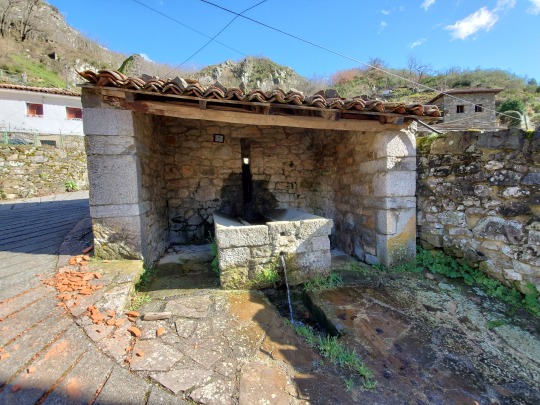

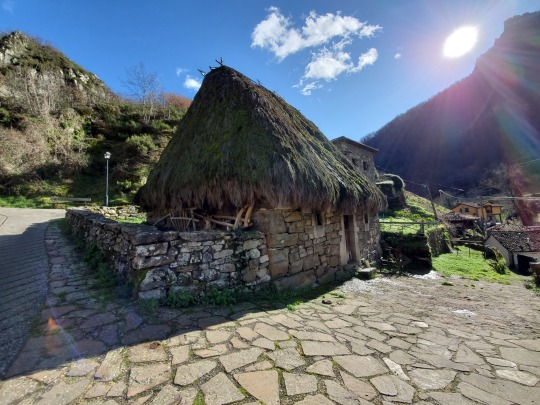
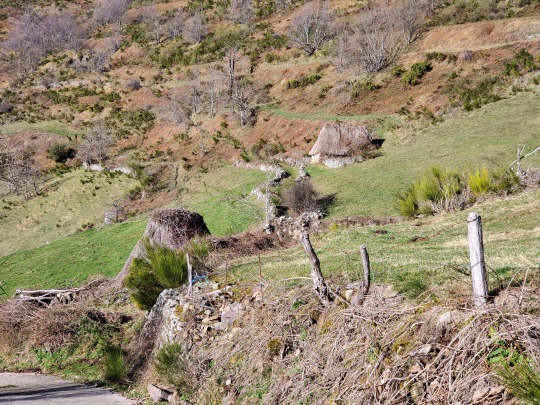
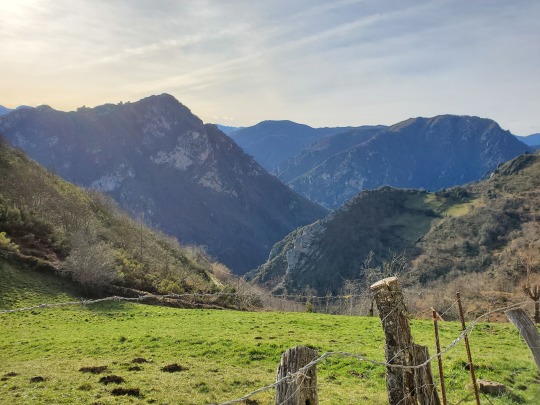


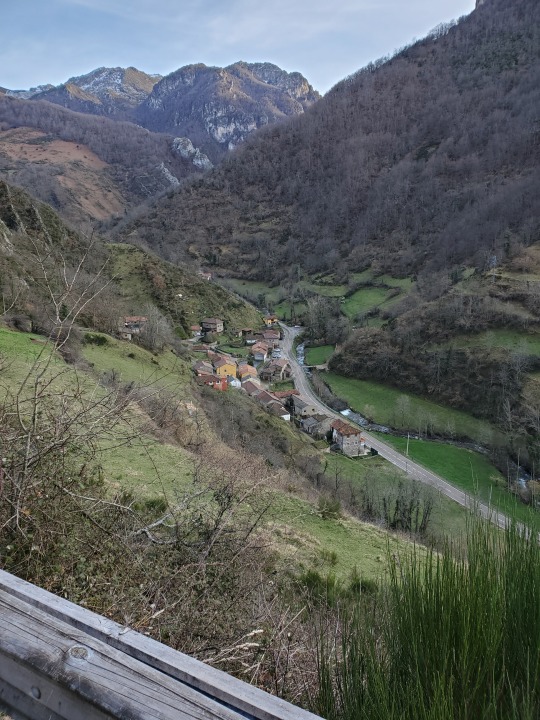
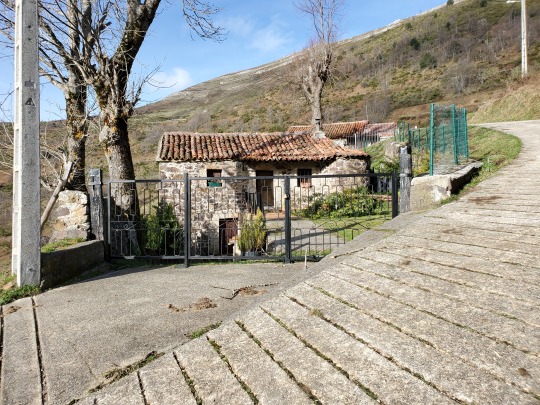

Okay! I said that i would post braña photos!
These are photos of La Falguera, one of the few summer brañas that remains inhabited. Many of the residents of La Falguera were part of the Vaqueiro minority that practiced arriería, transport of goods by mule, and they specifically transported grains from León to southwestern Asturias.
The second is Veigas. It is technically not a braña, it is head of the parish but it appears that all of the xaldo residents have left and all the residents today are Vaqueiros who have built some Vaqueiro structures. The xaldos left, looking for better economic prospects but the Vaqueiros, who have an ancestral connection to the land, their brañas in the mountains directly above Veigas, moved into Veigas to be close to them.
The thatched homes are Vaqueiro architecture called teitus, today they are mostly used for storage.
37 notes
·
View notes
Text


I saw some beautiful asturianas in the braña
#vacas#cows#this one lets me pet her nose#but just the wet part#asturiana de los val.les#vaqueiros de alzada#ok to rb
2 notes
·
View notes
Photo


Fotos de los Vaqueiros d’Alzada n’Asturies
1: Un home vaqueiru colos sos touros
2: Muyeres vaqueires de trés xeneraciones na so cocina
Photos of Vaqueiros de Alzada in Asturias
1: A Vaqueiro man with his bulls
2: Three generations of Vaqueira women in their kitchen
Más información sobro los Vaqueiros d’Alzada / More infomation about the Vaqueiros de Alzada
4 notes
·
View notes
Photo
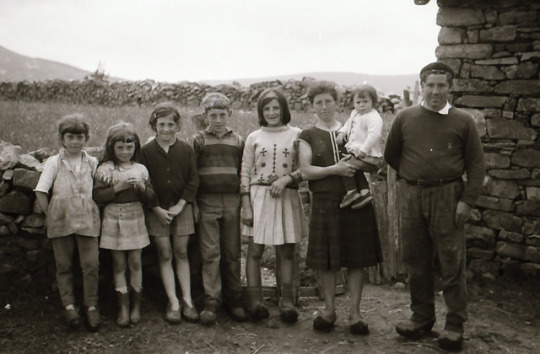
Retrato de familia, Maria Catédra, 1971
Image of a family of Vaqueiros d’Alzada, a nomadic group native to western Asturias and north-western León in Northern Spain. The Vaqueiros d’Alzada are a pastoralist ethnic group that migrate Asturias and León with their cattle, though few live the traditional Vaqueiro lifestyle today. They have their own distinct culture, folklore, costume, and dialect and have a long history of discrimination within Spain.
#i have a longer more informative post on vaqueiros in my queue#but im thinking to break it up into several posts#but here´s kind of an entry#i have tons of photos saved i´m gonna post#but#:+)#asturies#asturias#vaqueiro#vaqueiros de alzada#vaqueiros d'alzada#djente#people#espanya#españa
16 notes
·
View notes
Text
Re: the conversation on the colonialism and racism of cottagecore, it's very clear that Europeans think indigenous people don't exist where they live or that they're indigenous because they're Irish or whatever the fuck, so as a Vaqueira, I think it’s time Europeans start understanding whose land they’re on and that there are indigenous people everywhere, so i've made a short, incomplete list of indigenous and nomadic peoples of Europe. Feel free to look up more about them, especially if you're living on their land:
Abazins (Russia, Georgia, Abkhazia)
Adyghe/Circassian people (Russia, Turkey)
Aromanians/Vlachs (Greece, Romania, Albania, Serbia, North Macedonia, Bulgaria)
Ashkali Romani (Kosovo, Albania, North Macedonia)
Avars (Russia)
Balkars (Russia)
Bashkirs (Russia)
Basque people (Spain, France)
Bats people (Georgia)
Bergitka Romani (Poland, Slovakia, Hungary)
Boyash Romani (Romania, Hungary, Croatia, Serbia, Slovakia)
Boykos (Ukraine, Hungary, Slovakia, Poland)
Calé Romani (Spain, Portugal, France)
Cascarot Romani (France, Spain)
Chechens (Chechnya, Russia)
Crimean Tatars (Crimea)
Dargins (Russia)
Erlides Romani (Greece)
Erromintxela (Spain, France)
Finnish Kale Romani (Finland, Sweden)
Gagauz people (Moldova, Ukraine)
Gorani people (Kosovo, Albania, North Macedonia)
Gurbet Romani (Bosnia & Herzegovina, Serbia, Kosovo)
Hutsuls (Ukraine, Romania)
Ingush (Russia)
Irish Travellers (Ireland, UK)
Izhorians (Russia, Estonia)
Kalderash Romani (Romania, Ukraine, Bulgaria, Russia)
Karelians (Finland, Russia)
Komi people (Russia)
Laks (Russia)
Laz people (Turkey, Georgia)
Lemkos (Ukraine, Slovakia, Poland)
Lezgins (Russia, Azerbaijan)
Lipka Tatars (Poland, Lithuania, Belarus)
Livonians (Latvia, Estonia)
Lom people (Armenia, Georgia)
Lovari Romani (Hungary, Slovakia, Poland, Czechia, Germany)
Manouche Romani (France)
Maragatos (Spain)
Mari people (Russia)
Mingrelians (Georgia)
Mordvins (Russia)
Norwegian Travellers/Fanter (Norway)
Ossetians (Russia, South Ossetia, Georgia)
Pasiegos (Spain)
Polska Roma (Poland)
Mercheros (Spain)
Romanichal (UK)
Romanisæl (Norway, Sweden)
Ruska Roma (Russia, Ukraine, Belarus)
Sámi people (Sweden, Norway, Finland, Russia)
Sarakatsani (Greece, Bulgaria, Albania, North Macedonia)
Scottish Travellers/Indigenous Highland Travellers (UK)
Servitka Roma (Ukraine, Russia)
Setos (Estonia, Russia)
Sinti (Germany, Austria, France, Italy, Switzerland, Czechia, Netherlands, Belgium, Serbia, Croatia)
Tat people (Azerbaijan, Georgia, Russia)
Udi people (Azerbaijan, Armenia, Russia, Georgia)
Udmurts (Russia)
Ursari Romani (Romania, Bulgaria, Moldova, Serbia, Italy)
Vaqueiros de Alzada (Spain)
Veps (Russia)
Volga Tatars (Russia)
Welsh Kale Romani (UK)
Yeniche people (Germany, France, Belgium, Switzerland, Austria, Luxembourg)
Also to mention:
The millions of Jews whose homes, property, and land was stolen and never returned when they were murdered in the Shoah.
The hundreds of indigenous peoples of Asian Russia which is frequently seen as part of Europe because of its colonization by Russia.
There are many peoples that are known by few. There may be very little to no information about them in English or any language besides the official language of the country they are in. They may not have a written tradition and all written accounts of them are in old print books. They may be known only by people who live near to the region where they are. I know this is certainly true for Vaqueiros and the nomadic peoples of Spain.
Indigenous and nomadic peoples of Europe may be called ‘hill peoples’, ‘nomads’, or ‘cursed peoples’. They have lived in your country for hundreds or thousands of years, but were or are still not considered proper citizens. They live in their own territory by their traditional lifestyle, or in the city as part of your society, or in diaspora across the world. They unequally face land theft and environmental racism. They are hardly represented, if at all, and face challenges like insufficient infrastructure, education, healthcare, or access to water. It's time to learn who your neighbors are. We want to be known. We are in small numbers because of the land theft and cultural destruction by the European countries you live in.
If this description rings a bell for you, or if your group isn’t up here, feel free to add an indigenous or nomadic people in Europe you know!
DO NOT fuck around on this post or i will tear your head clean off
#there are peoples i didnt include on this list for a reason#see: the irish statement#cottagecore#indigenous#nomadic#also i decided to divide up the romani subgroups bc i divided the tatar groups#also i feel like some western europeans have the impression#that romani people do not live/are few/dont have a distinct culture in their country#hmmm!#i tried to find links that didnt use the G word#but it was very hard
2K notes
·
View notes